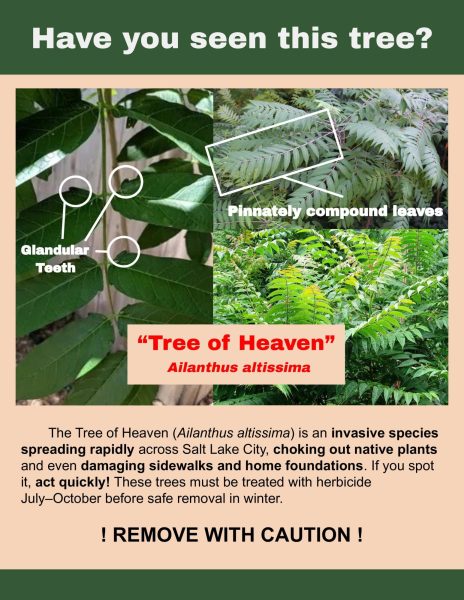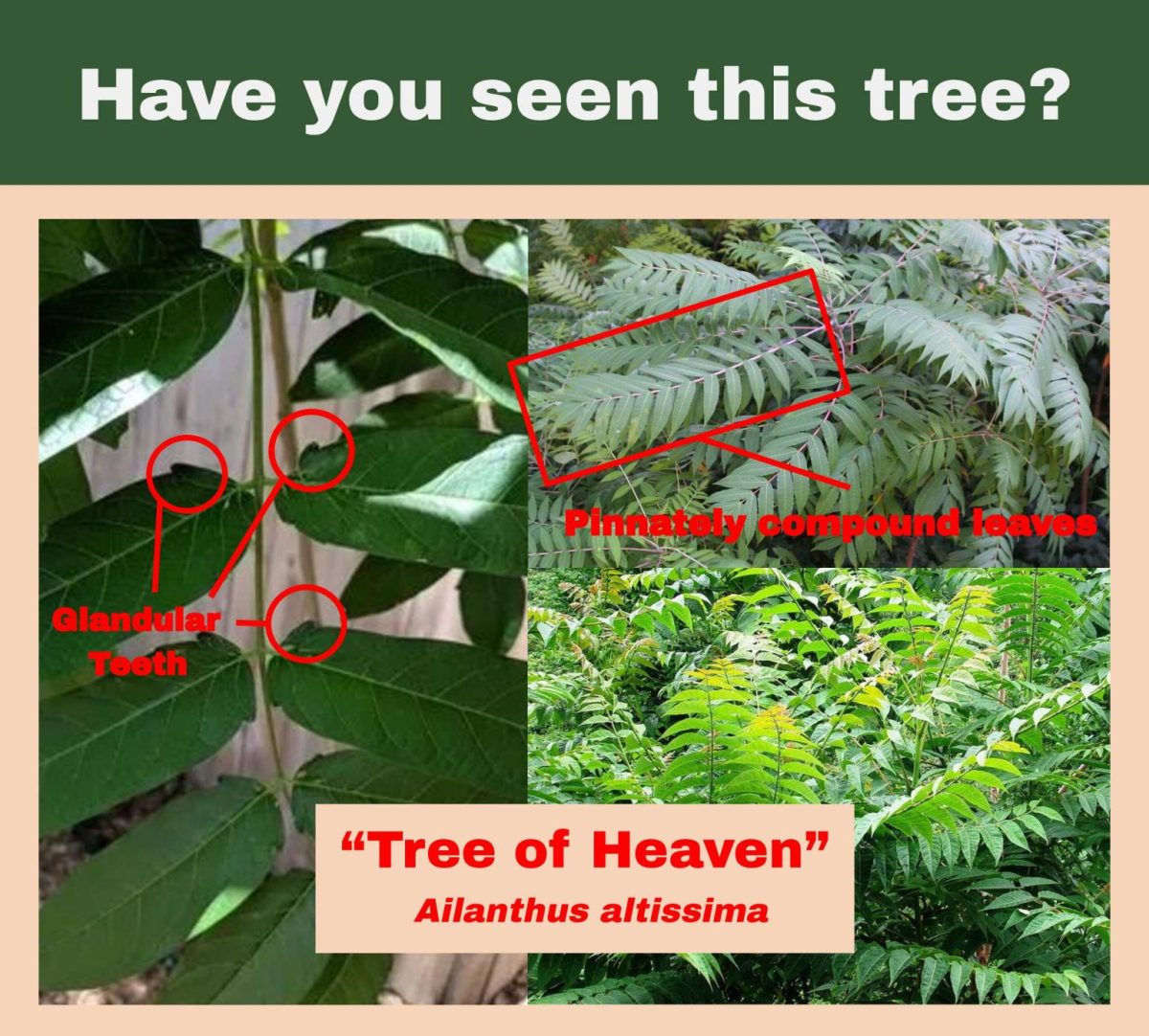The first thing they don’t tell you when you move away from home: When you begin living on your own, you are expected to learn to garden in ways you never have before.
In the last year that I have lived in Salt Lake City, I have been hounded by the ever present microecosystem of local flora, and the disapproving glances of the young family who lives next door to me. In an effort to not be the college eyesore of the street I regularly try to pull what most consider “weeds”, and return our front yard to a state of only slight aesthetic discomfort.
What I never considered, was that my greatest heartache would come not in the form of the common dandelion or crabgrass, but the inappropriately named Ailanthus altissima, the “Tree of Heaven.”
I first noticed this tree growing in my front yard last fall (the fall of 2024). It had grown so fast that it tipped over, causing it to continually grow in a sort of 45º angle away from our home and towards the sidewalk. This leaning obelisk-tic protrusion was then–not only obstructing our front yard bushes–but the natural light of our dining room. It was at this very same time that our large front yard bush (that houses a family of Pacific Wrens) began to rot away before my very eyes.
The second thing they don’t tell you when you move away from home: When your 6 foot tall front yard bush begins to die, it is not only somehow your fault, but also your problem.
Using the Lowes Rewards card my father gifted me, I bought a large pair of gardening shears and began to shred the bush. I reduced not only its size but its grotesque ailments that had been on display for the whole neighborhood.
However, I found that no matter how much I trimmed and pruned, the rot kept spreading. Starting at the base of a branch the leaves would begin to turn orange, shriveling up until all that was left was the dried-out husk of what was once a flourishing kaleidoscope of overlapping branches and intertwining leaves. I tried to prune lower and lower, but when I hit the stump of the bush, I found that the diameter of the mainstem was simply too vast. It subsequently began breaking my shears, causing me to give up on the project for the remaining gardening season.
It wasn’t until this summer, when I sat on my front porch on wicker chairs stolen from a frat house by a freshmen year roommate, that I surveyed the 540 square feet comprising my front yard that had been overtaken by the weeds and thought to myself, “something must be done about this.”
The third thing that they don’t tell you when you move away from home: If you don’t get to dealing with your weeds fast enough, your neighbors will try to do it for you.
On a fateful June afternoon one of our friends had come over to share her knowledge in Subaru oil changes from her Forester to my roommate’s Impreza. I thought to myself that now was as good of a time as any to pull the front yard weeds that had been taunting me since my spring semester classes ended. While my friends removed the Impreza’s oil filter I removed the silent choir of my personal leafy torturers.
It was then that I heard the tiny pitter patter of three-year-old feet that belonged to my neighbors’ very cute and very nosy daughter. She asked what my roommate was doing to her car, popping down on the sidewalk beside them.
Soon the three-year-old was followed by her father and our neighbor who, with I assume to only be the best intentions, said to us, “Well if my kid is watching you, and I’m watching my kid, I might as well make myself useful.” Taking his own pair of working, non-broken gardening shears he set about demolishing the collection of the tiny trees that had been sprouting around our bushes, including our home grown obelisk.
It made our yard immediately look cleaner–as if respectable people lived there. However, the enthusiasm our neighbor had in manicuring our lawn without even taking a moment to ask any of my roommates or my consent brought two thoughts to my mind: 1) All of my fears were true, our neighbors think our yard it so so ugly and he was probably just aching for the chance to mow down the terrible terrors spouting around our house. 2) Does he know something we don’t?
One google search later found that the trees sprouting all over our house went by the nickname “the Tree of Heaven,” due to its ability to grow so very tall and so very fast that it portrays the image of frantically reaching for the heavens. Ailanthus altissima, the so-called “Tree of Heaven,” is a deeply invasive species native to central China and considered ecological terrorists to the ecosystems of Europe and North America. The tree’s invasionions are so successful due to its parasitic nature: it sprouts in the existing, nutrient-rich soil of other plants, essentially strangling native plants within inches of their original home. This is the culprit of my front yard’s slow decay. I thought my yard was a big burning bush home hospice care, when really it was the residence of an angel of death, working in real time.
But then, as if I was living in my own Greek lesson of morality and universal truths, we discovered that the Tree of Heaven cannot be eradicated through brute force.
Ailanthus altissima grows through an interconnected root network stemming from a “parent tree” that, when cut down, will send a series of signals that will sprout dozens of buds polluting the ground where the slaughtered tree once stood. This communication network can span up to a 50 foot radius around the parent tree, of which will reach heights of 60-90 feet in its lifetime.
These nefarious, root-system-bound trees not only siphoning the water supply from our big beautiful bushes (in a time of drought no less), but are also known to irrevocably destroy sidewalk slabs and home foundations. In Salt Lake City, the average age of the typical house is 62 years old, with the median year of construction being 1963. Reader, my home was built in 1922. Reader, this means that as of 2025, my home is the ripe, fragile age of 103 years old. I cannot emphasise enough the dire nature of the situation this has left me in. Since the brutal desecration of these heavenly trees in June by my goodhearted neighbor that was unfortunately uninformed of the defensive nature of Ailanthus altissima, they have returned by the dozens. One could confuse my yard with deciduous forest.
The fourth thing they don’t tell you when you move away from home: You cannot stay complicit when an invasive asian tree is suffocating your yard–you must act.
After a deep dive reddit search conducted by my roommate we found that there is a solution: poison.
How to Poison the Tree of Heaven. A Guide by Emilie Bailey.
First: Locate Your Tree.
Ailanthus altissima is a tall, skinny tree. The bark is a grey color with a very smooth texture. The lanceolate leaves present as a bright green arranged into compound structure. Its distinguishing feature? Glandular teeth located on the base of the leaves. These are small protruding bumps with a wart-like appearance that contain glands that secrete allelopathic chemicals. The chemicals are used in the functions of (a) inhibiting the growth and germination of all the surrounding plants and (b) killing all surrounding plants by releasing Ailanthone into the soil. This kills everything in the surrounding soil while also preventing anything else from sprouting. Horrifying. Furthermore, these chemicals are known to discourage any herbivore snacking by producing a foul smell similar to cat urine or rancid fish. Crushing the leaves to test for this odor is a good technique to distinguish this tree from other native species.
Now, don’t worry, because it gets even worse. This tree houses the infamous spotted lanternflies, Lycorma delicatula, which not only use the Tree of Heaven as sustenance, but also as its primary host for egg laying. The moth is also an ecological crisis indicator. If you see one you are advised to kill it on sight. “It’s imperative to immediately report it online or via phone by calling 1-888-4BADFLY. Especially if you are not inside the quarantine zone. What else? Kill it! Squash it, smash it…just get rid of it. In the fall, these bugs will lay egg masses with 30-50 eggs each. These are called bad bugs for a reason, don’t let them take over your county next.” (Commonwealth of Pennsylvania n.d.)
Second: Applying Your Poison.
Negating all sacrilege, be sure to commit the poisoning between the months of July to October for most successful results. During these summer months, the tree will actively translocate photosynthates. This means that all of the organic compounds that are produced during photosynthesis are actively moving from the source (the photosynthesizing leaves) to the sink (the roots of the tree). Applying herbicide during these crucial growth periods allows the poison to move most effectively throughout the tree. You are then able to remove the tree during the off season–November to April–by cutting them down and digging the stumps up. The timing of this operation is crucial, as the tree won’t soak in the poison unless it is in this active growth state. Essentially, you can’t be poisoned if you’re not eating.
You will need herbicides containing either glyphosate or triclopyr. Either one will work fine, however for best results use both mixed together. You apply these toxins in one of three ways:
a. Foliar Application: intended for trees no taller than 8-10 feet growing in tight clusters with one another, simply spray a thick layer of these herbicides across the leaves, being sure to avoid any non-Tree-of-Heaven vegetation.
b. Basal Bark Application: intended for larger trees processing mainstems up to 6 inches in diameter. One then must spay down the entire circumference of the tree from the ground up 16 inches.
c. “Hack and Squirt” Application: Of the three choices this is reportedly the technique that yields the most successful results. Hacking and squirting is intended for your largest trees, however it can be used on all sorts of sizes given the diameter of the mainstem is greater than 1 inch. This method requires the user to to cut several 45º angled cuts into the trunk of the tree using a hatchet. It is indescribably impertinent to remember that you mustn’t hack off too many chunks thereby causing the tree to collapse upon itself as you will most certainly be in a worse position than you began. Into the cuts you must then funnel your poison, avoiding excessive run off. Continually repeat the “squirting” until you begin to observe the leaves closer to the base wither. Once the top of the tree turns orange you will know that you have won.
Third: Removing Your Tree.
Given that you are operating in the months of November to April and your poisoning proved successful, the next step is to cut down the terrible terror and use it for firewood. You must then dig out the stump, roots and all, and dispose of it similarly.
Fourth: Aftercare.
Over the next 1-3 growing seasons monitor the site closely, immediately applying the foliar or basal bark treatment to any new sprouts. Additionally, be sure to plant native species in place of where the terroristic plant once stood in order to prevent recolonization.


After discovering this information, my roommate began attempting to use the “hack and squirt” method on some of the larger trees we had discovered in our backyard. However, we are poor college students, so we opted for a cheaper herbicide than the name-brand AquaNeat glyphosate. Two months of frequent attempted murder sessions yielded us poor results with more and more trees sprouting each day.
At this point, feeling personally victimized and in a state of terror, I got into my car in order to conduct a search for the strongest poison a Lowes rewards card can buy. I began reading label after label, searching ingredient lists for the answer to my many prayers: glyphosate and triclopyr. After 20 fruitless minutes I turned to the Lowe’s employee at the end of the aisle and asked him for his strongest and most potent poison. What he said to me shocked me to my core.
“Is this about the Tree of Heaven?”
I sat there in silence, my jaw agape, simply too stunned to speak. I asked him how he knew and he told me that the entire summer people have been coming into the store with the exact same problem as me. Once more I was met with horror: he informed me that they had nothing in store that could kill it. Explaining that since this is an in
vasive tree from another continent, they simply were not equipped to combat its all-consuming, homicidal nature. In fact, he told me that before this summer, he hadn’t even heard of this tree, let alone know it by name. This was bigger than just me and than my disapproving neighbors. Reader, this is when true fear began to encompass me.
While driving home I spotted not one, not two, but seven more of these heaven trees. I fear that if no one acts soon these trees will desecrate not only the local plants of Salt Lake City, but all the insects and animals that depend on them to survive. We may be in the middle of an ecological crisis rivaled only by Utah Lake’s common carp catastrophe of 1883.
The fifth thing they don’t tell you when you move away from home: not all stories have endings.
The Ailanthus altissima in my front yard has yet to stop its terrorization of me and my home. As I see it now, I have only 2 months left to weaken this tree in order to allow for its full extermination and eradication this fall. I wish I could provide a resolution or a story of victory, but at this point in time that truly remains to be seen. In the meantime, my neighbor must unfortunately watch as I continue to not cut down the noxious trees and begin the poisoning process in the next coming weeks. I implore all to educate themselves and everyone they know on the dangers of this tree, the Tree of Heaven, before it sends all of our native plants to hell.
Sources:



